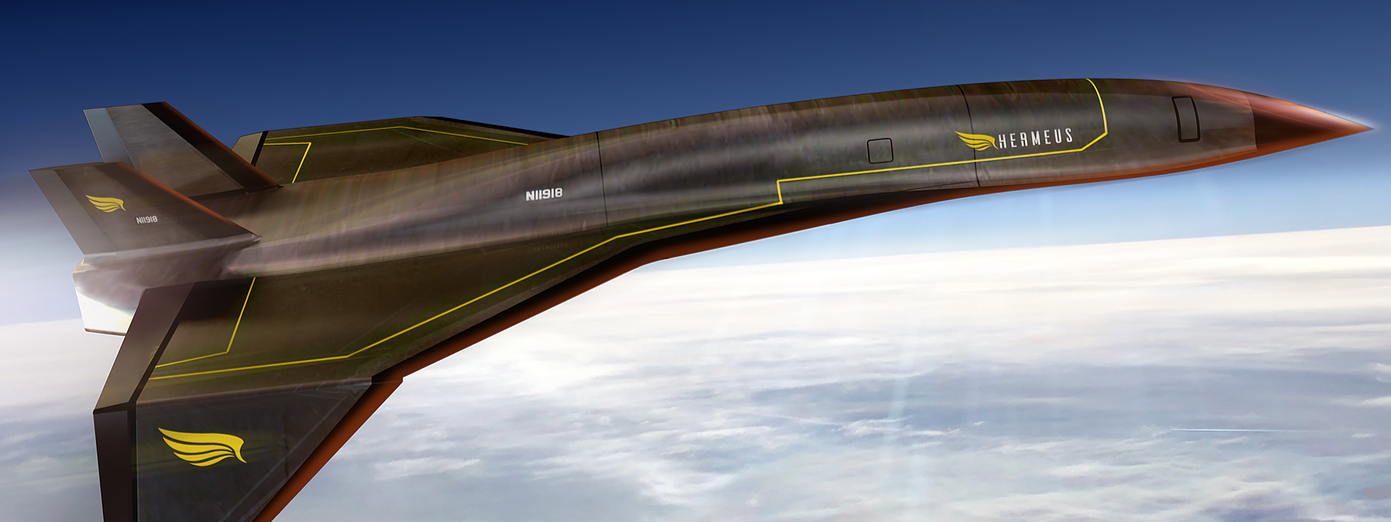
Hypersonic aircraft developer Hermeus is working with the U.S. Air Force to evaluate how the company’s Mach 5 concept could be modified into a high-speed executive vehicle, including potentially a presidential transport.
Encouraged by the Atlanta-based company’s swift progress towards test and development of a scaled prototype engine in February, the study contract was awarded by the Air Force’s AFWERX innovation arm. The work, which involves the Presidential and Executive Airlift Directorate, will focus on integrating the design with “unique Air Force requirements for high-speed mobility,” Hermeus said, as well as addressing the challenges of incorporating a hypersonic vehicle into the existing air traffic, airport and communications infrastructure.
The current Hermeus concept vehicle, which is configured to carry up to 20 passengers over trans-Atlantic distances, forms the basis for the Air Force study. The work also includes the preparation of risk-reduction test plans to support the Air Force requirements.
The contract, though relatively modest at $1.5 million through 2021, is nonetheless significant as it lays the groundwork for demonstrating Air Force requirements for commercial hypersonic flight, Hermeus said. With numerous new supersonic business jet and airliner options also emerging, the contract may also be a bellwether for future Air Force interest in acquiring other forms of high-speed airlift capability in the nearer term.
Hermeus is designing the aircraft around existing and near-term airframe, materials, systems and propulsion technologies to enable what it says is a more realistic entry-into-service goal around the end of the decade. However, tests of the turbine-based combined cycle (TBCC) engine at the core of its concept continue to be the key pacing technology for the program.
Tests so far have focused on a scaled TBCC prototype which is based around a 290-lb. thrust, off-the-shelf TJ100 turbojet supplied by Czech-based high-speed turbine maker PBS. The combined cycle elements include an in-house developed pre-cooler and a ramjet. The turbojet is designed to operate from a standing start to Mach 3.3, while the ramjet operates over the transition range from Mach 2.8 to above Mach 3 and then onward to power the vehicle to Mach 5.
Earlier this year Hermeus completed engine sea-level static testing at its own facility at DeKalb-Peachtree Airport, Georgia as well as a round of successful high-speed direct connect tests at Purdue University’s Zucrow Labs in West Lafayette, Indiana. According to Hermeus chief technology officer Glenn Case, overall testing has evaluated the TJ100 at flight speed conditions over Mach 3. “We’ve pushed the ramjet mode to Mach 4-5 conditions, demonstrating full-range hypersonic air-breathing propulsion capability,” Case said.
However, inlet and mode-transition tests, two of the most critical aspects of TBCC operation, still remain ahead for the company, which aims to undertake both “within the next 12-18 months.”


Comments
This would make it impossible to communicate with the president should the need arise. Hypersonic travel would require the president to pass the "football" (nuclear launch codes) to the vice president everytime he got on Air Force 1. The laws of physics make this idea is dead on arrival.